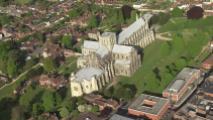
Cathedrals and Abbeys.
Today is all about the nave. The cruciform layout of a church is based on the points of the compass. The chancel, where the high altar is situated, points to the East and Jerusalem, which in Medieval times was the centre of the Earth. The north and south transepts were where chapels were often added, and to the west is the long nave, which is much longer in cathedrals than churches.

While the chancel with its quire (choir) and Lady Chapel, were the reserve of the clergy, tombs of the nobility and the privilege of the wealthy, the nave was for the laity. Unlike today’s cathedrals, where the vast stretch of the nave is filled with pews or chairs, in the Middle Ages, it would be bare. The commoners would congregate, not just for prayer, but to meet and exchange news. It was a community hub. Pilgrims would arrive, weary from long journeys, seeking out relics and the altars dedicated to the saints. They would kneel in prayer, hoping to be one step closer to God.
For a humble peasant, the scale of a cathedral’s nave would be both a daunting and amazing sight to behold. No other buildings were as grand as a cathedral or abbey. It’s like seeing a skyscraper for the first time.
While continental European cathedrals are renown for their height and breadth, making them the largest in terms of floor space and height, English cathedrals are longer and its all down to the length of the nave.
Liverpool Anglican’s cathedral might be the largest church in Britain (3rd in the world), but it is Winchester cathedral that holds the record for the longest intact Medieval cathedral in Britain – 170m (558ft) and 7th in the world.
Winchester’s old minster was the burial site of King Alfred the Great and King Cnut. However, the Normans demolished it and used the stone to build the cathedral in 1093. The limestone was also used and transported from the Isle of Wight; hauled from quarries on trackways, then by barge across the Solent.
The original transept crossing collapsed in 1107 and its demise was blamed on the unpopular William Rufus who was buried beneath the floor of the crossing in 1100. The heavens disapproved of the king. In later Medieval times, the nave was remodelled in the perpendicular style and encased in Caen stone. Each extension elongated the church and flying buttresses were added to support the weight of the stone walls.
In second place (just) for length of the nave is St Albans – 167.8m (551ft) of which the nave is 84m (276ft).
St Albans was founded as a St Benedictine monastery and abbey in 9th Century and built amongst the ruins of the Roman town Verulamium on the River Ver. The current layout dates from Norman times and was the largest abbey of its time – the nave had ten bays. In 1190s it was extended by 3 bays as the number of monks increased. An earthquake in 1250 caused damage to the east end of the chancel.
After the Dissolution of the monasteries, the abbey suffered greater neglect. The lady chapel became a school, the gatehouse was a jail and the Puritans, during the English Civil War, removed metal work and ornaments (the Roundheads did more damage to churches and cathedrals, than the Dissolution – an overlooked fact.)
In 1770s the abbey came close to being demolished – more storms, more cracks, more floods. Repair efforts began in Victorian times and in 1872 the See of St Albans was created. St Albans was saved.
It would a shame to lose such an ancient building. Imagine the gossip in the nave!















Very interesting post. I visited Westminister Abbey and the Canterbury Cathedral while in England. They are amazing structures filled with much more than the architecture and building. God is apparent in both places. I was spiritually awed!
LikeLike
Today’s post is all about Westminster Abbey. The architecture is amazing when you think they were built without the help of cranes and machinery.
LikeLiked by 1 person
Very interesting. I particularly like the tidbits of history about socialising in Medieval naves 🙂
@JazzFeathers
The Old Shelter – 1940s Film Noir
LikeLike
Now days we’re expected to be quiet in churches, but back then, the nave would have been bustling.
LikeLike
Beautiful photos of cathedrals and interesting information about naves. Yes, I would have loved to hear the gossip in the nave when talk of demolishing arose.
#AtoZChallenge http://gail-baugniet.blogspot.com
LikeLike
Eavesdropping would have been fun.
LikeLike